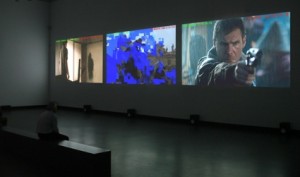 The video installation relies on an automated system that downloads continually the most popular torrents. The intercepted data is immediately projected onto a screen before being discarded.
The video installation relies on an automated system that downloads continually the most popular torrents. The intercepted data is immediately projected onto a screen before being discarded.
The flows appearing on the screens constitute a sort of 'surveillance' of the peers as fragments of the files that they are exchanging can be visualized during the transmission or the reception. The remote users are, unknowingly, composing an endless collage determined by what they chose to download.
...
Didn't you fear that you might get into trouble?
We thought about it, we were particularly concerned about the exhibition spaces, but the legal aspects are very schizophrenic. It is obvious that the peer-to-peer structures have positive cultural impacts and also often positive social ones. The same questions were asked with the arrival of photocopiers, audio cassettes, VHS, etc.. The main stumbling blocks remain the obsolete structures of film and music production.
See the original stories here: http://we-make-money-not-art.com/archives/2013/05/the-pirate-cinema.php?utm_source=feedburner#.UZpW6pX6LiN
and here: http://www.theverge.com/2013/5/20/4347484/the-pirate-cinema-nicolas-maigret-peer-to-peer-piracy-art-installation?curator=MediaReDEF